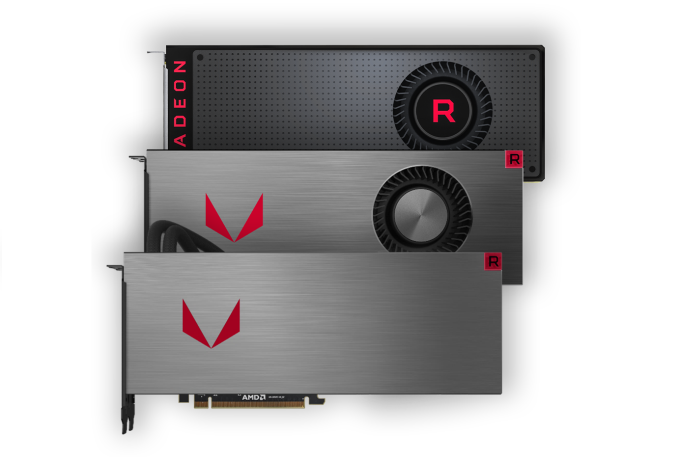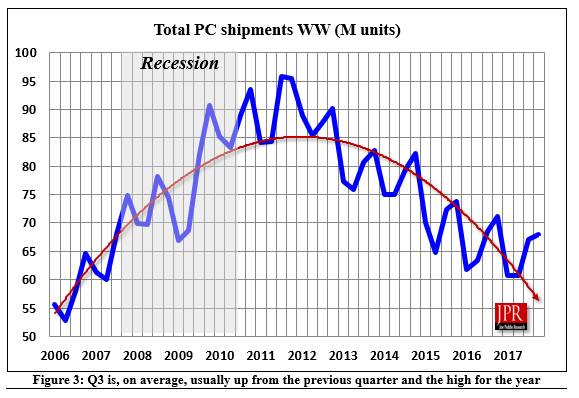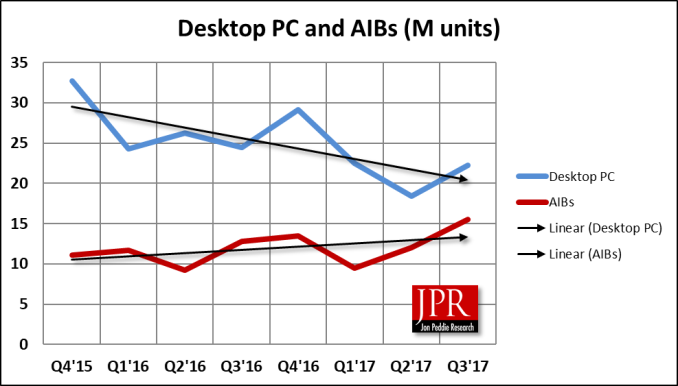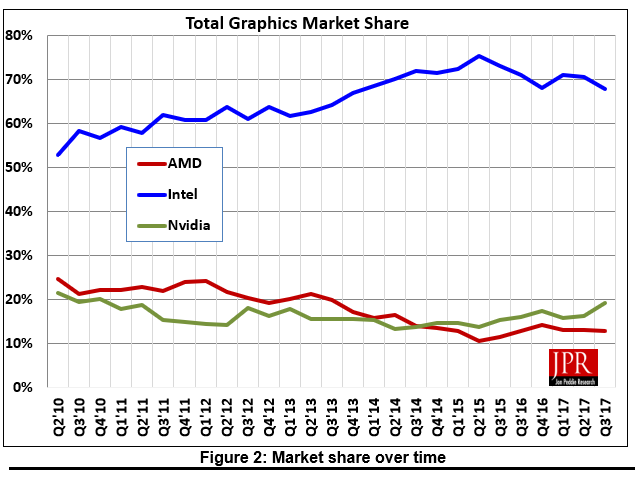Cryptomining Demand Wanes as Q3 2017 Discrete Graphics Cards Shipments Hit 5-Year-High
by Nate Oh on December 1, 2017 9:00 AM EST
This week, Jon Peddie Research (JPR) released their quarterly discrete video card sales report for Q3 2017. According to JPR's figures, the quarter was a strong one for discrete desktop GPU shipments, with vendors shipping upwards of 15 million units, reaching volumes not seen in four or five years. This high point in card shipments was fueled by positive seasonality, desktop PC gaming, and the tail end of cryptocurrency mining demand, leading to add-in board (AIB) shipments increasing 29.1% over last quarter, more than double the 14% ten-year Q2-to-Q3 average increase. In terms of discrete desktop graphics market share, NVIDIA gained around 3% compared to JPR’s revised Q2 figures, putting the balance at 27.2% for AMD and 72.8% for NVIDIA.
In context, the GPU and PC markets fluctuate in a relatively consistent seasonal pattern: shipments trend flat to down in Q1, notably down in Q2, notably up in Q3, and up to flat in Q4. Also in context, of course, is the effect of cryptomining mining demand on last quarter’s shipments, resulting in an unseasonal increase from Q1 2017. JPR notes the waning demand of Ethereum-driven cryptomining, but concedes that it continues to have an impact that is “still just as impossible to accurately measure.”
These reports of both strong seasonality and weakening cryptomining are corroborated by AMD and NVIDIA’s latest quarterly fiscal results, the former bringing AMD back in the GAAP earnings black and the latter posting yet another record quarter. AMD attributed the 74% year-over-year revenue growth in their Computing and Graphics segment to strong Radeon and desktop Ryzen sales, observing a strong increase in GPU average selling price (ASP). And while on the subject, higher ASPs are certainly not news to many consumers in the market for a mid-range graphics card, with little reprieve as the holiday season approaches.
As for NVIDIA, they attributed continued sales of Pascal based gaming GPUs in growing their quarterly Gaming segment revenue to $1.561 billion. By nature of miners buying GeForce cards, that number includes some amount of cryptomining demand. But in looking at cryptomining specifically, NVIDIA does record crypto-specific boards separately as part of their OEM & IP segment, and they saw sales of those crypto board drop to $70 million from the previous quarter’s $150 million.
So for explaining Q3’s strong AIB shipments beyond Ethereum, JPR unsurprisingly points to gaming PCs, highlighting AMD’s Ryzen Threadripper CPU launch and Intel’s response. Which in this case would entail engaging AMD in core wars with Skylake-X and later two-upping their 16 cores with 18 under a new ‘i9’ branding. Among the report’s other considerations are the continuing popularization of eSports and desktop gaming PCs over mainstream general purpose PCs. The end result is Q3 2017 AIB shipments edging over 15 million units, a figure closer to quarterly volume in 2013 and a 5-year-high since the roughly 17.5 million units shipped in Q3 2012. But JPR also sees the high water mark of Q3 2017 as evidence for the return of traditional seasonality, in the sense that it suggests Q4 2017 shipments will be flat to down. From the standpoint of noticeably waning cryptomining demand and probable lack of major GPU launches, this is arguably more likely than not.
Such atypically high volume always has the potential to affect market share, and for Q3 2017 NVIDIA had the upper hand with their discrete desktop GPU shipments up 34.7% from last quarter, compared to AMD’s 16.1% increase. In terms of market share, this resulted in NVIDIA picking up 3.1%, slowly widening what has been a roughly 70-30 split of the past year with AMD. While the major launch of Q3 2017 was the Radeon RX Vega cards in August, the mid-quarter timing should be noted, as well as the limited post-launch availability that afflicts high-end card launches in general.
Keeping to JPR’s numbers for comparison purposes, the market share impact of RX Vega is likely to be smaller than previous launches as only the high-end and lower-volume RX Vega 56 and 64 have been released, as opposed to if a fuller stack with Vega 11 were trickling out. But given the turbulence of cryptomining, it seems more likely that the broader impact (or non-impact) of RX Vega and even RX 500 cards will not be clearly visible for another quarter or so.
Wrapping things up, the total graphics share, which encompasses discrete and integrated GPUs for desktop and mobile, saw NVIDIA gain more ground mostly at the expense of Intel. Beyond discrete desktop GPU shipments, NVIDIA saw a notable 22.4% increase in discrete notebook GPU shipments. In the aggregate, JPR reports that AMD’s overall unit shipments increased 7.6% quarter-to-quarter, Intel’s shipments increased 5%, and NVIDIA’s shipments increased by a much higher 29.5%. In the next couple years, we may start to see some interesting shifts with AMD’s Zen-based APUs and Intel’s revived determination to develop discrete high-end GPUs. The union that is Intel’s processor with AMD Radeon graphics is unlikely to be high-volume but will be intriguing nonetheless. And as for NVIDIA, their numbers continue to speak for themselves.
Source: Jon Peddie Research















23 Comments
View All Comments
tipoo - Friday, December 1, 2017 - link
Thank goodness it's waning, for the rest of us.Question is, can AMD put in even their 27% performance with crypto out of the picture next year?
StrangerGuy - Friday, December 1, 2017 - link
Won't be pretty. If you look at the market share histogram, AMD lost more than half of their marketshare when the last cryptocrash happened. If the same trajectory happens again they will be looking at a measly ~15% overall and god knows how much they will get outsold by NV in the >$300 bracket as if they aren't already.vanilla_gorilla - Friday, December 1, 2017 - link
So when can I actually get a VEGA 56 at MSRP and not $200 over it?lefty2 - Friday, December 1, 2017 - link
Is there any solid proof that crypomining is waning?RX 580 and GTX 1070 prices are still way over MSRP.
Nate Oh - Friday, December 1, 2017 - link
For the conclusions that JPR are making, the solid proof would be in the data and work they've done. The full data, of course, is detailed in the paid report that we don't have access to. At some point, we do have to trust JPR, historically a reliable firm, when they publicly say that cryptomining is decreasing.On your second point, GPU manufacturers are not drastically increasing supply in response because of the extensive lead-time of production and uncertainty of the cryptomining bubble, among other reasons. So current prices of mid-range cards are not necessarily indicators of cryptocurrency mining not softening. Here, the work done by JPR would be likely be more accurate than a current shortlist of consumer-facing e-tail prices.
Yojimbo - Saturday, December 2, 2017 - link
The Anandtech article has the headline "cryptocurrency demand wanes", which is a little different from your question about evidence that "cryptomining is waning." When journalists write headlines they seem to write them as if the thing they are reporting is happening now, even if it's something that has already happened in the past. I think a better question would be "Is there any solid proof cryptomining has waned?"The JPR press release says "Cryptocurrency mining was not as big influence in the AIB market this quarter as it was in the lat. Nonetheless, cryptocurrency mining (especially Ethereum) is still a factor in the market, and still just as impossible to accurately measure."
Saying it wasn't as big of an influence is not a very strong statement. They aren't saying there's a trend that they expect to continue, only that in Q3 the effect was not as strong as Q2. They didn't even quantify how much the effect waned, only that they think it did in some measurable sense. They even go on to admit that they are having trouble measuring it.
I am going to guess that JPR are looking at historical trends of the reaction of the GPU market to other things they can measure, such as the sales of new games and the category those games fall under. I would guess that in Q2 those other numbers didn't seem to match with the sales of GPUs (many more GPUs were sold than would be expected by the historical correlation), but in Q3 the match was stronger. Also, quarter over quarter, desktop PCs ticked up in Q3 while they were down pretty strongly in Q2, and I am guessing they can be sure that gaming GPUs sold in desktop PCs are part of the gaming market.
But yeah, it looks to me that there is a small price difference between the 1070 and the 1070 Ti. Since the 1070 Ti seems to be faster in gaming but about the same in mining Ether as the 1070, it seems that there is still an effect of cryptomining on the the market. But availability seems to be higher and the prices don't seem to be as out of line as they were in July and August, particularly with the AMD cards. If so, that supports JPR's assertion. I think cryptocurrency has been a larger percentage of sales for AMD than for NVIDIA, which explains the larger effect it's had on the price of AMD's cards.
yensteel - Friday, December 1, 2017 - link
Not really waning, actually, just calm before another storm. Mining profitability heavily relies on hashrate and electricity efficiency. If electricity is completely free, then any GPU can generate profit as long as it can continue working. Therefore, people are waiting for the next GPU generation for maximum profit and are worried that they will make their current ones obsolete, hence not buying as much as of now.Nate Oh - Friday, December 1, 2017 - link
Well, waning and waxing go together, so couldn't be both 'waning' and the 'calm'? :)HStewart - Friday, December 1, 2017 - link
I personally think this Cryptomining stuff is extremely bad thing and hopefully one day eliminated from the systems just as much as we attempt Virus, Malware and such. Malwarebytes recently reported issue with a site cause issue with eating system resource related to CryptominingTotal GPU shipments is interesting, unless you are living in fantasy land - it points to how much the industry has turn mobile. As for discrete GPU on mobile, it probably only a small percentage of mobile cpu and will likely only take away from desktop GPU markets as the industry goes more mobile.
I serious doubt Intel is planning to use Raju for extremely high GPU - my bet his knowledge be used in more Intel's primary market which is now Mobile systems. It is naïve to think that Intel EMIB is just for AMD Radeon GPU - with the fact that 2017 numbers show that Intel lost some of Market from NVidia not AMD - Intel will like also have a version with NVidia GPU - but in long run that will be new GPU from Raju,
Yojimbo - Saturday, December 2, 2017 - link
You seem to be implying that the GPU market for high-end gaming is shrinking, but we know that isn't the case. It is enjoying healthy growth. Don't confuse the overall PC market with the gaming market. Analysts made that mistake for years but now they have learned better.Regarding Intel, they came out and said they wanted a high end GPU. Perhaps the main reason they want it is for data center acceleration, particularly of deep learning applications. But if they are going to build one they are going to attempt to go after whatever markets having one allows them to profitably compete in. Perhaps something else that convinced them to build a high end GPU now is this graphic, the graphic that refutes what you claim about discrete GPUs becoming irrelevant: https://images.anandtech.com/doci/12107/aib-001.pn...
Intel probably had a strategy of swallowing up more and more of the discrete GPU business with their integrated GPUs. But that has not come to pass. Discrete GPUs are only becoming more important in the most lucrative areas of the market, and Intel has even recently had to turn to an AMD GPU to compete with NVIDIA because their integrated GPUs are not powerful enough for their customers.